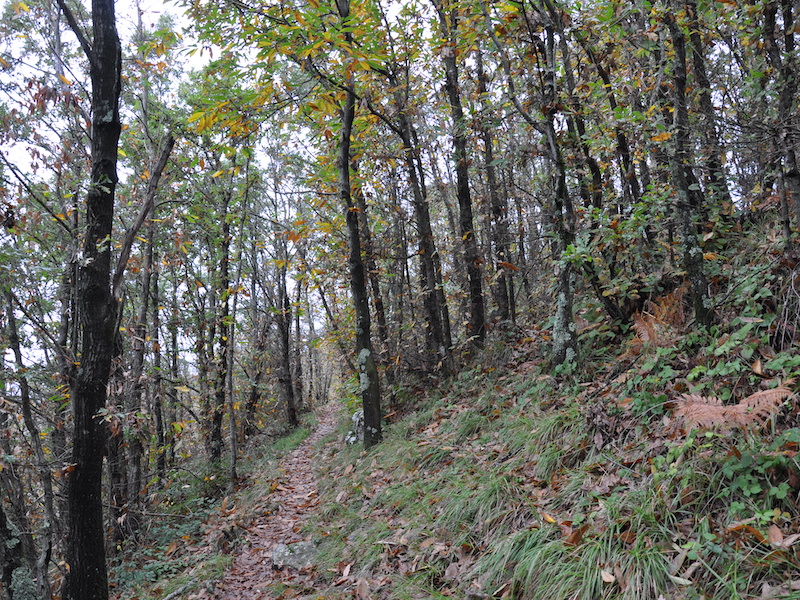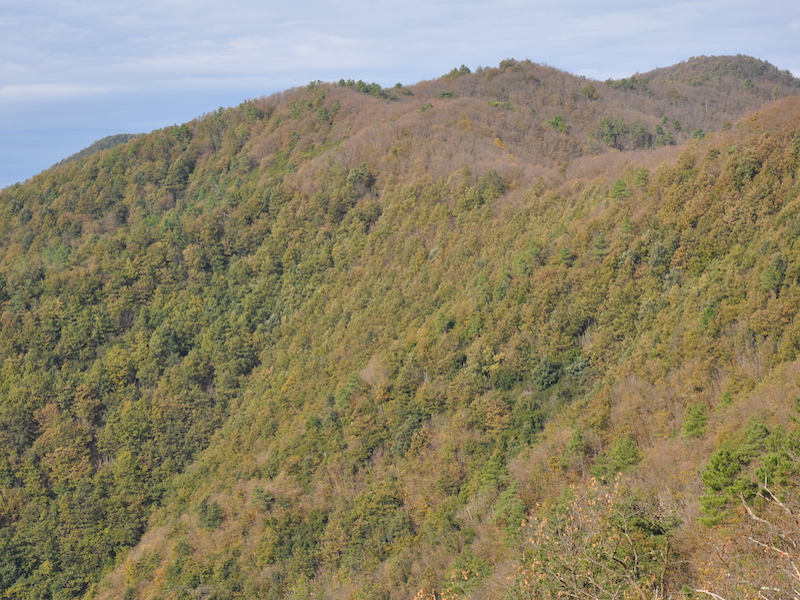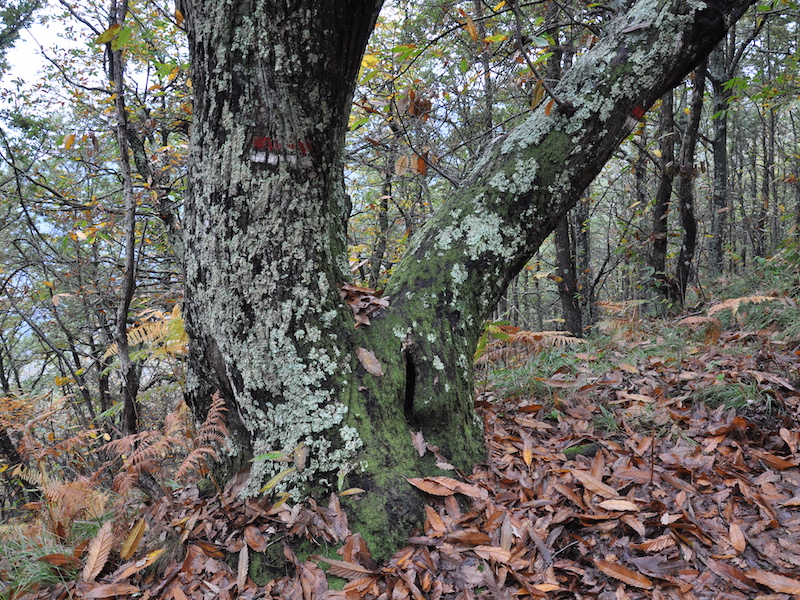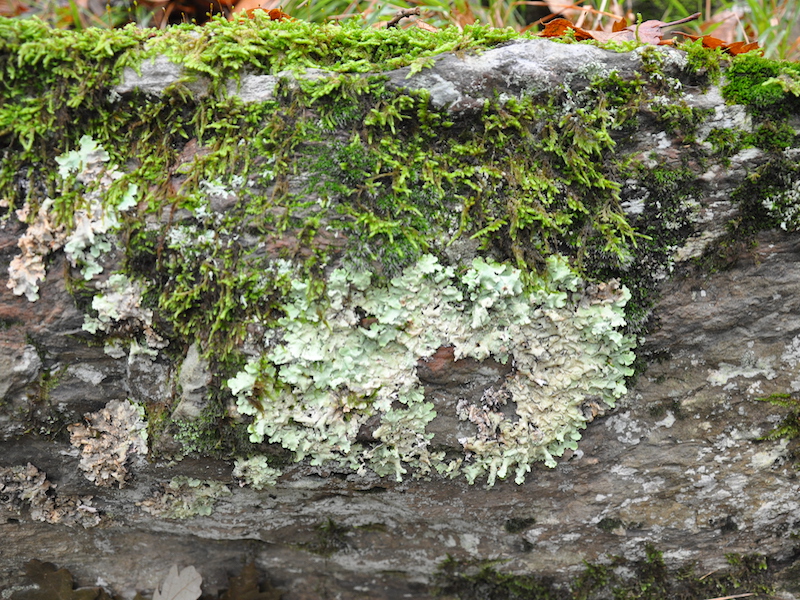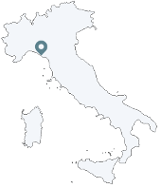Mixed woods, where diverse conifer and broadleaf species grow, are the most common type of forest in the National Park, and their composition varies according to elevation and aspect of the slopes. In lower and hotter areas hop-hornbeams
(Ostrya carpinifolia L.), downy oaks
(Quercus pubescens Willd.) and manna ashes
(Fraxinus ornus L.) predominate; on the sunnier ridges the maritime pine
(Pinus pinaster Aiton) is the main species; at a higher elevation and to the north, where humidity is higher and temperature lower, chestnut trees
(Castanea sativa Miller) and Turkey oaks
(Quercus cerris L.) form almost pure woods.
Together they represent a complex and diverse environment that changes with the seasons, as the foliage varies in colour and thickness; moss, ferns and lichens cover the rocks and tree bark; grasses and shrubs add to the flora.
The dwellers of these woods are ungulates (wild boars and roe deers), foxes, badgers, squirrels, weasels and beech martens; the branches and trunks are a refuge for northern goshawks, tawny owls, little owls, woodpeckers, dormice; mice and water voles dig galleries in the ground; insects move all around.
Timber, fruits and products of the undergrowth used to be an important source of income for the local economy; this is why the municipalities of Monterosso and Vernazza - whose wooded territory includes the basin of the Vara river - where historically richer than Riomaggiore, whose borders don't stretch beyond the watershed.
The "Alta Via delle 5 Terre" and the paths that link it to the inner areas are an opportunity to enjoy a mountain hike with a view of the sea.
The chestnut tree (Castanea sativa Miller) This is a massive tree in the family Fagaceae that can be up to 30 metres tall, 20 metres in circumference, and thousands of years old. It is a deciduous broadleaf with an expanded, round crown. The straight trunk is smooth when the tree is young; later, the bark gets thicker and deeply furrowed. Its alternate, coriaceous leaves are wide and lanceolate. Its light yellow flowers are grouped in conspicuous, pendulous inflorescences (aments). The fruits, i.e. the chestnuts, are contained in a spiky sheath, the burr. The tree can propagate either via seed or by sprouting new basal shoots, making it possible to obtain timber of different sizes. Chestnut woods - coppices to produce timber, or orchards to obtain chestnut flour - used to be at the centre of economy for many mountain peoples, which is why the chestnut became widespread: it can be found in man-grown pure woods, or in mixed mesophilic woods together with oaks, hornbeams, ashes. Chestnuts prefer deep and loose soils, neutral or slightly acidic, and the cool and humid mountain climate between 600 and 1,300 metres a.s.l., i.e. the phyto-climatic zone Castanetum. This tree is distributed throughout the Mediterranean, from the Iberian Peninsula to the Caucasus. A monumental chestnut grows just outside the National Park, at a spot called Isola along Path No 551: it is 20 metres tall with a circumference of 470 cm, and over 300 hundred years old.
(See gallery) Fungi Fungi or mycetes are a kingdom that also includes yeasts and moulds. They are unicellular or multicellular organisms without differentiated tissues, lacking chlorophyll and unable to synthesise nutrients, and therefore needing already processed organic matter. Unlike plants and animals, fungi do not have an embryonic stage but propagate by dispersing spores. They don't have a stem, or roots, leaves, or a vascular system to transport sap: they consist of the mycelium, a network of thin filaments called hyphae. What we usually call fungus is actually the carpophore, i.e. the fungus' fruiting body that carries the spores, and we call forest mushrooms the large epigeous fungi, whose fruit body develops above ground. Fungi are 85% to 90% water: humidity and rain are therefore fundamental for them. In a natural ecosystem fungi play the crucial role of transforming the organic matter produced by other organisms, both vegetal and animal, so that it does not accumulate indefinitely. If they develop to the detriment of a living organism, fungi are called parasites, if they exclusively feed on dead organic matter they are called saprotrophs: either way, through their enzymatic apparatus they can process complex structures that would otherwise not alter, and give back to the soil compounds (in the form of humus) that plants are able to assimilate, thus allowing the forest to renew.
(See gallery) Lichens Lichens are composite organisms arising from the association of two simpler ones: algae and fungi. Their mutualism ensures their survival, because the fungus absorbs nutrients from the substratum and the alga, which is an autotroph, processes these nutrients through photosynthesis. The two symbionts therefore live together with mutual benefits: the alga gets mineral salts, water and protection from the fungus; the fungus in turn gets the organic compounds produced via the photosynthesis. This association makes it possible for lichens to spread in inhospitable and even extreme environments, on surfaces that are seemingly very poor in nutrients and exposed to the weather. Researchers also study lichens because of their absorption ability, especially of metals in the air: they serve therefore as bioindicators, as the analysis of their tissues allows to assess the concentration of pollutants in the atmosphere.
(See gallery) Silvia Olivari


